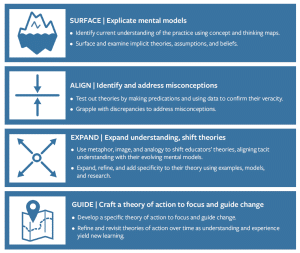Sabotage! How Our Implicit Biases and Mental Models Keep Us From “Walking the Talk”
CompetencyWorks Blog
This post is part of a series inspired by the new report: Teachers Making the Shift to Equitable, Learner-Centered Education: Harnessing Mental Models, Motivations, and Moves.
Why do so many teachers who say they believe in equitable, learner-centered education struggle to “walk the talk”? Learning science may hold some clues.
Cognitive scientists suggest that we all hold implicit biases and theories—referred to as mental models—that represent our deeply held beliefs and conceptions of the world. We use our mental models to interpret and make sense of new information, and to run simulations that help us to make predictions about outcomes and the best course of action in a given situation. The problem is that once fully formed, our mental models reside outside of our attention and awareness and can sabotage our best laid plans and intentions. As explained in our “Caution: Change Ahead” blog post, this means that teachers can espouse theories—what they say they believe—that may differ from their “enacted practice”—what they actually do in their classrooms.

Implicit bias is a type of mental model that we all hold. When teachers have implicit bias, this can have particularly adverse consequences for their students. In their report, Unconscious Bias in the Classroom: Evidence and Opportunities, the authors explain that “Unconscious bias crosses multiple intersections of identity, including race, gender, class, sexual orientation, religion, and region.” In a recent nationwide study of teachers’ implicit racial bias, researchers measured the extent to which teachers associate certain positive and negative characteristics with differing racial groups. Their results showed an association between these ratings of implicit bias and racial disparities in achievement and disciplinary records.
Shifting Mental Models: It’s Harder Than You Think!

In order to adopt a more equitable, learner-centered approach, teachers can shift their mental models toward increasingly inclusive and constructivist theories of teaching and learning. The difficulty is that simply introducing educators to equitable, learner-centered practices does not appear to work. For instance, research examining the impact of introducing teachers to learning science research has found that teachers with increased factual knowledge about the brain are still likely to adopt misinformation.
Similarly, efforts to shift teachers’ implicit bias are also fraught with challenges. In their 2021 article “The illusion of equity in PD,” author Tucker-Smith explains:
“… diversity, equity, and inclusion training and professional development (PD) often fall into one of three categories: (1) equity PD that works; (2) equity PD that doesn’t work; and (3) equity PD that looks like it works but doesn’t” (p. 72).
She argues that effective professional learning strategies aimed at equity help teachers to uncover their implicit assumptions about students, foster a growth mindset, and guide teachers in making changes in their practice to be more equitable, until these changes become “habits.”
There are likely multiple reasons why teachers’ outdated mental models persist. The question is: What can designers of professional learning do about it?
In order to adopt a more equitable, learner-centered approach, teachers can shift their mental models toward increasingly inclusive and constructivist theories of teaching and learning. The difficulty is that simply introducing educators to equitable, learner-centered practices does not appear to work.
Four key steps in helping educators identify those aspects of their practice they want to keep—and those aspects of their practice they want to grow or change—include the following, which can also been seen in the graphic below:
- explicating mental models,
- addressing misconceptions,
- expanding understanding and shifting theories, and
- crafting explicit theories of action to guide change.
Addressing educators’ mental models is a key strategy in the initial phases of a change effort. Additionally, it is equally critical for educators to revisit and make refinements to their theories of action throughout the process to maintain a clear focus on the desired practice goal and enable them to see the evolution of their mental models as their understanding deepens and develops over time.
“What” Goals and Strategies

Ready to Get Started?
To design professional learning with these principles, click on the button below to access examples, resources, and practices used by one school to uncover and revise mental models needed to guide change.
Learn More
Check out the other Making the Shift blogs and professional learning exercises designed to address the hidden drivers of teaching practice that can thwart change efforts!
- Making the Shift: Why Is It So Hard to Scale Equitable, Learner-Centered Education?
- Caution: Change Ahead! How Harnessing Emotions and Motivations can Help Drive Change for Equitable, Learner-Centered Education
- Old Habits Die Hard: How to Build New Moves and Habits to Sustain Change
- Professional Learning Exercises for Teachers Making the Shift to Equitable, Learner-Centered Education
Dig deeper into the theory and research underlying an equitable, learner-centered approach in the Making the Shift report.

Wendy B. Surr is a senior research consultant and project director with more than 30 years of experience leading research and evaluation studies, state and local education initiatives, and technical assistance services. Surr specializes in the development of assessment systems designed to measure learner-centered teacher practices and associated student deeper learning outcomes. As a Senior Researcher at the American Institutes for Research (AIR) for seven years, Surr conducted numerous research studies examining learner-centered, competency-based, and deeper learning practices and led the study Learning with Others, which examined the role of collaboration in enhancing outcomes for students of varying racial and ethnic backgrounds. In the past three decades, Surr has led numerous technical assistance projects, including: partnering with the Illinois State Board of Education to launch a statewide competency-based learning initiative with over 45 districts, serving as lead for the Regional Deeper Learning Initiative, which helped the states of Ohio, Illinois, Indiana and Iowa to advance deeper learning and competency-based education practices; and developed and launched CBE 360, a multi-state professional learning initiative focused on the dissemination of a comprehensive toolkit designed to support implementation of CBE practices by districts, schools, and classroom educators. Surr holds a B.A. in Psychology from Bard College and an M.A. in Early Childhood from Tufts University.
